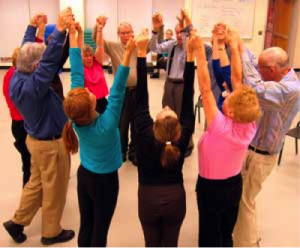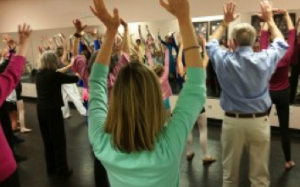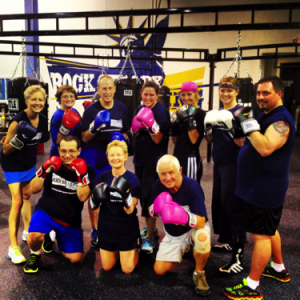Community Classes for Parkinson Disease
Created by Kenzie Owens, SPT

Background
My work in Health and Wellness and Evidence Based Practice II (EBP II) led me to consider the benefits of community exercise classes for those with Parkinson Disease. In the Health and Wellness course, I wrote my program proposal for a dance class combined with strength training to address falls risk in those with Parkinson disease. The statement of need and further background information on this patient population can also be found in the program proposal. I completed my Critically Appraised Topic (CAT) in EBP II on a clinical question comparing the effectiveness of dance to balance exercises in decreasing the falls risk of an older adult patient with Parkinson Disease. This older adult patient is my grandfather and my motivation behind this project. The report I completed for the Motor Learning and Motor Control course contains additional information about his case and community exercise of interest.
Project Overview and Products
After completing my CAT, I was interested to learn about the benefits that community exercise classes may provide those with Parkinson Disease. I reviewed the literature to determine the benefits of dance, LSVT BIG, and boxing for those with Parkinson Disease. As my last rotation is in inpatient rehabilitation at Roper, I wanted to additionally determine the location of these classes in the community and provide this information to patients in a brochure.
In addition to the patient brochure, I created a handout for the physical therapists at Roper. This handout assumes a therapist education level and includes answers to questions the patient may have in addition to the benefits of dance, LSVT BIG, and boxing and the locations of these classes. My hope is that these materials will increase long-term participation in community exercise classes for those with Parkinson Disease.



Assessment
Health literacy was important to consider in the development of the patient brochure as those with Parkinson Disease may have cognitive issues. After reviewing the voicethreads on health literacy, I decided to keep my document in bullet format, condense the bullet points to create more white space, and include only the information that would be most important and meaningful to the patients in order to motivate them to participate in the exercise classes. I think this simplified the document and will allow patients to focus on the benefits that they may experience and how they can find the classes. I also increased the font size so that the brochure would be easier for patients to read and changed to question format to further engage patients. I additionally improved the health literacy of my brochure by simplifying the wording and provided the information at the 6th grade literacy level.
Throughout the completion of this project, I sought feedback through email communications with my advisor and committee members. After completing the health literacy assessment, I thought that it might be helpful to provide a separate brochure to therapists using more technical terms defining the specific benefits each class may offer their patients. My advisor agreed with this suggestion but also proposed that I include a shortened version of the references I removed during the health literacy assessment in order to appropriately acknowledge the sources. I completed drafts of the patient and therapist brochures and sent them to my committee members. It was suggested that I incorporate questions patients should ask their therapist in the patient brochure and the answers in a more detailed therapist handout as these answers may vary by patient or over time. It was also recommended that I include a short description of the exercise classes in the patient brochure and the link for the Rock Steady website that will allow patients to search for boxing classes worldwide.
Though I think I did well requesting and integrating feedback from my advisor and committee members, I would meet in person or over telecommunications with my team if I were to complete a project like this in the future. If schedules permitted, this would promote discussion between team members regarding goals and ideas for the project. Nevertheless, communicating individually with my team resulted in a product that a committee member remarked is “very helpful” and we are excited to see how these materials go over in the clinic setting.
Acknowledgements
I would like to thank my advisor, Prue Plummer, and my committee members, Karen McCulloch and Carol Giuliani, for providing me with helpful feedback throughout the creation of this project. You all have assisted me in developing these materials into products that may be clinically useful and beneficial for those with Parkinson Disease. Additionally, I would like to thank my classmates, friends, and family for their continued moral support throughout the completion of this project.

4 Responses to “Community Classes for Parkinson Disease”
Mackenzie Owens
Kate, Meredith, and Tyler,
I greatly appreciate your comments! Kate, the Chapel Hill Parkinson Support Group is an excellent resource for physical therapists to share with patients in this area. Information on the exercises classes for those with Parkinson disease in the Chapel Hill area can be found at the following link: http://chapelhillparkinsons.weebly.com/local-eventsclasses.html. I hope your parents decide to participate in ballroom dance classes again! Meredith, LSVT BIG is billed under insurance just as a physical therapy session would be and the instructors are therapists that have become certified in LSVT BIG. After reviewing the literature, I think it would be appropriate for a patient with mild to moderate disease severity that you deem to be safe to participate in community activities, through the utilization of outcome measures and your clinical judgment, to take dance while also undergoing physical therapy. Tyler, I think instructing Rock Steady Boxing classes would be the perfect way for you get involved in the community given your interests! I do feel that reviewing the evidence supporting these classes inspired me to become more involved in these programs by volunteering in Dance for PD classes. I may also consider becoming a certified instructor or therapist for the Parkinson Wellness Recovery Program to increase the availability of classes for patients in Charleston. More information on the Parkinson Wellness Recovery Program can be found at the following link: https://www.pwr4life.org/pwr-workshops/.
Thanks again,
Kenzie
Tyler Shelton
Kenzie, thank you for producing such an interesting and helpful product! I’ve personally done some individual research in order to get more involved in the boxing for Parkinson’s classes locally, and completely agree that these group classes are instrumental in improving mobility and quality of life for these patients. Your statement of need for the “Tango for Two” class can easily be applied to all of these resources/classes. I found your pamphlet for physical therapists and other clinicians to be a very helpful guide, that I would love to use and refer to as a professional. I also appreciate how you tailored the patient brochure to improve patient comprehension. Patient education on the merits of these courses is a significant aspect of care that you addressed perfectly. The link you provided for Rock Steady Boxing is not only a great motivator for patients to get involved, but also for clinicians who are interested to become an active member of this program. Do you feel that your research on this subject has compelled you to become more involved when you graduate, and possibly implement and instruct some of these programs on your own to increase availability to your patients? Thank you again for this very well-done capstone. The resources you provided will be a fantastic guide for all of us as we enter the professional world.
Meredith Smythe
Dear Kenzie,
I really enjoyed reviewing your capstone materials. These seem like they will be helpful both to patients and therapists at your next rotation. The patient brochure was well laid out and easy to read with enough empty space and nice use of photographs. The writing was simple and clear; it would be appropriate for multiple reading levels. It also included very helpful resources for specific places to take dance, boxing and participate in LSVT BIG. I was interested to learn that LSVT BIG is billed under insurance. Howe does this work? It says in your handout for therapists that LSVT BIG is conducted by a certified clinician. Does this mean they are a physical therapist?
What I really liked about the therapist handout was that you gave the therapists specific answers to common questions. I really appreciated that you knew the prices of the classes as well as the normal duration in addition to the locations to take the classes. I wanted to make sure that I understood a part on the second page correctly. According to the research is it appropriate for a patient to take dance while undergoing physical therapy? Great job on this project!
Meredith Smythe
Kate Nagel
Hi Kenzie! Great job on your project! This capstone has a special place in my heart since my Mom was recently diagnosed with Parkinson’s Disease. My parents actually met at a ballroom dancing class, so I love seeing the benefits of dance in this patient population from your brochure and handout. From improving balance and walking speed, and also slowing some of the disease severity, like rigidity, I know that I need to push my parents to take dance lessons again! I particularly liked how you created both a brochure to hit the basic information, and a handout that actually answers the questions in the brochure and provides more detailed information. I know that you utilized resources in South Carolina, but are you aware of any resources in North Carolina off hand? I feel like these resources will be a great resources for PTs to provide to their patients, and I’ll definitely be sharing the information with my Mom. Nice job!